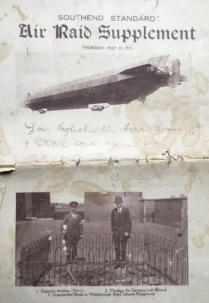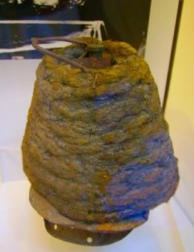Air Raid-May 1915

Southend-on-Sea
It
had
been
a
sunny
fun
filled
day
at
Southend,
as
night
drew
in
the
townspeople
had
gone
to
bed
not
giving
a
thought
to
what
the
seemingly
peaceful
sleeping
hours
would
bring.
The
night
was
dark
and
moonless,
in
the
early
hours
of
the
10th
May
1915
small
clouds
were
seen
skipping
quickly
across
the
dark
sky,
the
sun
was
still
a
few
hours
from
rising
over
the
horizon.
Higher
in
the
sky
lay
a
haziness
which
made
it
difficult
to
detect
anything
moving.
It
was
at
such
a
favourable
juncture,
that
the
blow
was
struck
and
fell
upon
the
unfortified
watering-place
of
Southend-on-Sea.
It
was
not
the
first
air
raid
on
Southend
but
this
time
it
would
be
the
deadliest, for the few minutes the raid lasted, it would see houses wrecked and one woman dead.
Where the bombs fell
Over
100
bombs
were
dropped
by
the
Zeppelin
that
morning,
many
exploded
on
impact
luckily
for
those
below
many
more
failed
to
explode:
45
Ashburnham
Road:
Bomb
fell
into
back
bedroom
Mr
&
Mrs
May
escaped
with
their
baby
one
room
gutted
by
fire
one
damaged
by
water whilst fire crews were on scene.
65 London Road (junction Ashburnham Road): the home of Dr Henry Woolcraft-Hull badly damaged
The
Cromwell
Boarding
Establishment:
Bomb
fell
through
the
roof
and
first
floor
exploding
in
the
living
room
the
ensuing
fire
raged
for three hours destroying the building.
1
Richmond
Avenue
(off
London
Road):
bomb
hit
home
shattered
but
failed
to
ignite
the
four
adults
and
one
child
inside
the
property escaped.
7 Richmond Avenue: The home of Mr C. W. Pavey was badly damaged he escaped unharmed.
St John’s Road: two bombs fell in street.
Hamlet Court Road: Bomb fell through main window of Ainslide bros Butchers and failed to explode.
London Road: several bombs fell without exploding.
65
West
Road:
The
home
of
Mr
Pen
was
heavily
damaged
when
a
bomb
fell
through
the
roof
destroying
the
stair
case
and
setting
the
lower
half
of
the
house
on
fire
the
family
Mr
Pen
his
wife
and
two
daughters
had
to
jump
from
the
upstairs
window
the
pet
cat
died
in
the fire.
West
Road
(unknown
house):
A
boy
aged
4
and
his
Nanny
were
hurt
by
debris
after
a
bomb
fell
between
their
beds
but
failed
to
explode.
105 Baxter Avenue: House destroyed by fire.
120
North
Road:
A
bomb
fell
through
the
roof
of
the
home
owned
by
Mr
&
Mrs
Whitwell,
the
bomb
struck
Mrs
Agnes
Frances
Whitwell
as
she
slept
in
bed
killing
her
instantly
the
doctor
called
to
the
scene
described
her
body
as
“little
more
than
a
charred
mutilated
mummy”
she
was
60
years
old,
she
had
worked
for
the
Salvation
Army
for
35
years,
her
husband
survived
with
head,
shoulder, neck injuries & burns he was taken to the Victoria Hospital.
192
York
Road
East:
Bomb
fell
a
short
distance
from
St
Erkenwalds
Church,
the
shock-wave
from
the
blast
caused
extensive
damaged to the home of Mr & Mrs J. C. Warr who escaped with their two daughters.
Honiton
Road:
a
bomb
fell
on
open
land
between
Ambleside
Drive/Southchurch
Road/Honiton
Road
exploding
and
shattering
the
windows and blowing doors off buildings close by, the resulting crater measuring 8ft in circumference and 3ft deep.
Toledo Road: A small bomb fell on to open group leaving a 9 inch wide 4 inch deep crater.
J.
C.
Flayman
Builders
yard
Southchurch
Road:
Two
incendiary
bombs
fell
into
the
yard
and
immediately
set
fire
to
the
large
amounts
of
wood
stored
in
the
yard,
an
elderly
horse
stabled
in
the
yard
was
rescued
by
fire
crews
the
fire
took
five
hours
to
bring
under control.
Royal Terrace: Slight damage to the home of Mr Tolhurst.
Prittlewell
Square:
An
incendiary
bomb
landed
in
the
square
where
a
patrolling
police
office
collected
a
pail
of
water
and
threw
it
over
the
fizzing
bomb,
this
failed
to
extinguish
the
bomb
so
the
bomb
was
lifted
and
placed
in
to
a
second
pail,
the
water
boiled
for
three minutes.
40 York Road: Roof and ceiling damaged.
Cobweb
Corner
The
Technical
School:
Large
explosive
device
landed
five
yards
from
the
tramway
shelter
passing
through
the
wooden
decking,
and
concrete
path
but
did
not
explode
it
was
recovered
and
taken
to
Shoeburyness
for
evaluation,
the
extensive
damage became a tourist attraction!
Leigh Close: One bomb fell and exploded but little damage was caused.
5 Essex Street: Out building hit and slight fire damage caused.
15 Scratton Road: Bomb fell in back garden failed to explode.
The Beach east of the Pier: Single bomb failed to explode.
Beach west 100 years west of the Pier: Bomb failed to explode.
London Road: Outside the Electric Light Substation failed to explode.
Summer Court: Fence set on fire.
Nazarath House Convent, London Road: Two bombs fell in grounds.
The Great Eastern Railway Yard Southend.
St Vincent’s Road.
Campbell Road.
Coleman Street, Prittlewell.
2 Clifton Mews.
Harcourt Road.
Tudor Road.
Westcliff Sea Front: A single bomb fell in front of the Westwood Ho Hotel.
14 Grange gardens.
Carlton Drive.
Cambridge Road.
16 Princes Street.
68 Princes Street.
Essex Terrace.
Junction of North Road & West Street.
53 London Road.
Bentalls Farm, Prittlewell.
58 Cranleigh Drive: Incendiary bomb caused a fire that was quickly extinguished.
Marine Parade Westcliff.
Leigh
Gasworks:
Incendiary
and
high
explosive
bombs
were
dropped
in
the
area
around
the
Leigh-on-Sea
Gasworks
site,
28
various
bombs were later recovered from the foreshore those that fell within the site failed to explode.
Leigh Road: One bomb.
The Plough Public House, Westcliff: One bomb fell outside the pub and failed to explode.
Ceylon Road: Six bombs fell in a 100 yard stretch.
11
Rayleigh
Avenue:
One
bomb
fell
and
failed
to
explode
attached
to
the
bomb
was
a
piece
of
card
with
a
message
in
blue
pencil
reading “You English, We have come, We will come again, Kill or Cure”
The Aftermath
The
raid
resulted
in
eleven
houses
being
destroyed
and
countless
others
being
damaged.
There
were
countless
craters
caused
by
bombs falling onto open land and exploding others fell without exploding.
There
was
also
the
much
more
sobering
casualty
list,
dozens
had
been
hurt
but
despite
the
large
volume
of
bombs
that
had
been
dropped
only
one
person
had
been
killed,
this
was
Mrs
Whitwell
of
120
North
Road.
As
well
as
the
death
of
Mrs
Whitwell
the
raid
also killed a Dalmatian dog and a cat the estimated cost of the damage was put at £5301.
In
the
following
few
days
the
resentment
for
the
raid
boiled
over
and
riots
broke
out,
this
saw
the
German
owned
shops
in
the
High
Street
have
their
windows
smashed
and
properties
ransacked,
the
police
unable
to
deal
with
the
uprising
had
to
call
upon
the
Local
troops and Territorials stationed at Shoeburyness.
The Bombs
In
total
over
80
bombs
were
dropped
on
Southend
that
morning,
those
that
did
not
explode
were
recovered
and
examined.
The
incendiary
bombs
were
found
to
be
about
50lbs
in
weight
and
made
from
steelzine
tar,
wire,
filled
with
petrol
or
benzene,
charcoal,
a
channel
ran
through
the
body
in
several
places
containing
a
slow
burning
fuse.
Upon
impact
the
bomb
would
shatter
the
burning
fuse
which
in
turn
would
set
fire
to
the
flammable
elements
of
the
bomb,
the
tar
would
help
the
mixture
stick
to
whatever it touched.
Right: The Southend Museum owns one of the unexploded bombs (Photo 2008)
The Zeppelin
The
Zeppelin
that
carried
out
the
raid
that
day
was
the
LZ38
commanded
by
Hauptmann
Erich
Linarz,
the
first
flight
of
the
P-Class
Army
Zeppelin
LZ38
had
taken
place
on
3rd
April
1915.
The
airship
was
536ft
long
and
had
a
hull
width
of
61ft
its
max
weight
was
35721lbs,
cruising
speed
was
52kts
at
a
maximum
height
of
12795ft.
Propulsion
came
from
four
Maybach
MC-X
engines
each
giving
207hp.
The LZ38’s life was relatively short the bombing missions it took part in were:
Thursday 29th—Friday 30th April 1915: bombs dropped on Ipswich and Bury St. Edmonds.
Monday 10th May 1915: Bombs dropped on Southend (bombs dropped early hours of 10th).
Monday 17th May 1915: Bombs dropped on Ramsgate and Dover. (bombs dropped early hours of 17th).
Wednesday 26th May 1915: Bombs dropped on Southend.
Monday
31st
May
1915:
London
the
raid
saw
120
devices
being
dropped,
totalling
3,000
lb,
including
91
incendiaries,
28
bombs
and
two
'grenades'.
7
people
were
killed,
35
were
injured;
forty-one
fires
were
started,
burning
out
seven
properties,
damage
was
priced
at
£18,596.
The
LZ38
was
destroyed
in
its
shed
at
Evere
on
Monday
7th
June
1915
It
had
just
returned
from
an
aborted
raid
on
England,
when
the bombers struck the crew escaped.
The Controversy
In
the
days
after
the
attack,
two
local
newspapers
the
Southend
Standard
and
the
Westcliff
Graphic
both
printed
“Air
Raid
Supplements.”
These
two
publications
contained
full
details
of
the
level
of
damage,
the
roads
that
were
hit
and
named
those
injured
and
the
woman
that
was
killed.
At
the
time
publication
of
such
details
and
the
censorship
of
photos
was
regulated
by
the
Government,
so
that
the
information
on
the
efficiency
of
the
German
air
raids
would
not
be
used
by
spy’s
aiding
the
German
forces
to
improve
their
targeting.
The
publication
of
the
supplements
caused
a
storm
in
Parliament
but
as
the
supplements
were
already
in
general
circulation
there
was
little
that
could
be
done to re-call the offending material.
Southend Timeline Southend-on-Sea © 2009 - 2024. All Rights Reserved
The Zeppelin Returns
Southend
had
little
rest
before
the
return
of
the
Zeppelins
on
the
26th
May
1915,
again
it
was
the
LZ38
commanded
by
Linnarz
the
mission
was
originally
to
find
a
safer
route
to
bomb
London.
The
Zeppelin
was
first
sighted
of
Clacton
at
10:30pm
it
then
turned
to
go
over
Southminster
where
anti-aircraft
gunners
opened
fire.
The
craft
then
turned
South
and
headed
for
Burnham-on-Crouch,
before
passing
over
Shoeburyness,
the
local
3
inch
naval
guns
opened
up
on
the
LZ38
which
continued
onto
Southend.
The
raid
saw
some
70
bombs
being
dropped
resulting
in
three
fatalities
and
three
seriously
injured,
damage
to
buildings
was
light.
The
Zeppelin
then
turned
to
head
back
over
Shoeburyness,
when
the
3
inch
navy
guns
opened
up
on
it
once
again,
the
airship
carried
on
its
route
to
pass
again
over
Burnham-on-Crouch
before
the
ground
guns
picked
it
up
again
and
opened
fire.
Upon
reaching
the
mouth
of
the
River
Blackwater
LZ38
turned
out
to
sea
avoiding
the
five
RNAS
fighters
that
had
taken
off
to
intercept.
Two
of
the
fighters
were
involved in serious landing accidents.





Southend-on-Sea’s No 1 History Website! Documenting The Town & The Townspeople

Now Incorporating The Sea Of Change Website
Website Info:


Chalkwell ▪ Eastwood ▪ Leigh-on-Sea ▪ Prittlewell ▪ Shoeburyness ▪ Southchurch ▪ Thorpe Bay ▪ Westcliff-on-Sea
SOUTHEND CITY
































































